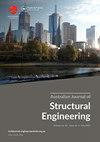Response of perforated H-pile subjected to coupled lateral displacement history and axial loading
IF 1.3
Q4 ENGINEERING, CIVIL
Australian Journal of Structural Engineering
Pub Date : 2022-11-25
DOI:10.1080/13287982.2022.2149914
引用次数: 1
Abstract
ABSTRACT The substructure of an integral abutment bridge is designed to accommodate the lateral demand induced by the expansion and contraction of the bridge deck. The assembly of H-piles oriented about their weak axis of bending and aligned in a single row with a rigid connection to the abutment is most preferred for supporting the integral abutment bridges. The weak axis orientation of H-pile allows for higher displacement capacity, thus accommodating the cyclic thermal demand induced by a superstructure. The hysteretic response of H-piles is suggestive of the early onset of the plastic hinge formation, which helps in accommodating the cyclic demand. The H-piles in the integral abutment bridge experience low cycle fatigue induced by cyclic thermal variations, resulting in the buckling of flanges at the critical zone. This study assesses the impact of perforation made on H-pile flanges at the critical buckling zone. In this study, six unique geometries of perforations are modelled and analysed using combined nonlinear kinematic and isotropic hardening formulation. The hysteretic response of the perforated H-pile models has been compared with an unperforated model to assess the proposed perforation geometry's impact on the H-pile's hysteretic response.横向位移历史和轴向荷载耦合作用下h形孔桩的响应
整体式桥台桥梁的下部结构设计是为了适应桥面膨胀和收缩引起的侧向需求。h型桩以弱弯曲轴为导向,排成一排,与桥台刚性连接,是支撑整体桥台桥梁的最佳方式。h型桩的弱轴向允许更高的位移能力,从而适应上部结构引起的循环热需求。h型桩的滞回响应表明塑性铰形成较早,有助于适应循环要求。整体桥台h型桩在循环热变化下经历低周疲劳,导致法兰在临界区屈曲。本研究评估了h型桩法兰在临界屈曲区穿孔的影响。在这项研究中,使用非线性运动学和各向同性硬化公式对六种独特的射孔几何形状进行了建模和分析。将穿孔h桩模型的滞后响应与未穿孔h桩模型进行了比较,以评估所提出的射孔几何形状对h桩滞后响应的影响。
本文章由计算机程序翻译,如有差异,请以英文原文为准。
求助全文
约1分钟内获得全文
求助全文
来源期刊

Australian Journal of Structural Engineering
ENGINEERING, CIVIL-
CiteScore
2.50
自引率
0.00%
发文量
31
期刊介绍:
The Australian Journal of Structural Engineering (AJSE) is published under the auspices of the Structural College Board of Engineers Australia. It fulfils part of the Board''s mission for Continuing Professional Development. The journal also offers a means for exchange and interaction of scientific and professional issues and technical developments. The journal is open to members and non-members of Engineers Australia. Original papers on research and development (Technical Papers) and professional matters and achievements (Professional Papers) in all areas relevant to the science, art and practice of structural engineering are considered for possible publication. All papers and technical notes are peer-reviewed. The fundamental criterion for acceptance for publication is the intellectual and professional value of the contribution. Occasionally, papers previously published in essentially the same form elsewhere may be considered for publication. In this case acknowledgement to prior publication must be included in a footnote on page one of the manuscript. These papers are peer-reviewed as new submissions. The length of acceptable contributions typically should not exceed 4,000 to 5,000 word equivalents. Longer manuscripts may be considered at the discretion of the Editor. Technical Notes typically should not exceed about 1,000 word equivalents. Discussions on a Paper or Note published in the AJSE are welcomed. Discussions must address significant matters related to the content of a Paper or Technical Note and may include supplementary and critical comments and questions regarding content.
 求助内容:
求助内容: 应助结果提醒方式:
应助结果提醒方式:


